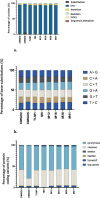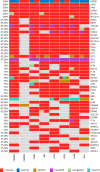Identification of mutations in canine oral mucosal melanomas by exome sequencing and comparison with human melanomas
- PMID: 39406779
- PMCID: PMC11480479
- DOI: 10.1038/s41598-024-74748-z
Identification of mutations in canine oral mucosal melanomas by exome sequencing and comparison with human melanomas
Abstract
Oral mucosal melanomas (OMMs) are aggressive neoplasms commonly found in dogs but rare in humans. Utilizing whole exome sequencing (WES), which focuses on protein-coding regions to reveal mutation profiles, we conducted a comparative analysis of canine OMM and human melanomas. This study involved DNA extraction, exome enrichment, and sequencing from three canine OMM cell lines (CMGD-2, CMGD-5, TLM-1), five canine OMM frozen samples, a human OMM cell line (MEMO), and a human commercial skin melanoma cell line (SK-MEL-28). The sequencing and subsequent analysis of FASTQ files yielded final variant files, leading to the identification of mutations. Our findings revealed a total of 500 mutated genes in canine OMM, including significant ones such as EP300, FAT4, JAK3, LRP1B, NCOR1, and NOTCH1. Notably, 82 shared mutations were identified between human melanomas and canine OMM genomes. These mutations were categorized based on the gene functions. The identification of these mutations provides critical insights that can pave the way for the development of novel therapeutic strategies for both canine and human OMM, offering hope for more effective treatments in the future.
Keywords: Exome sequencing; Melanoma; Mucosa; Mutations; Variants.
© 2024. The Author(s).
Conflict of interest statement
The authors declare no competing interests.
Figures







References
-
- Lourenço, S. V. et al. Establishment and characterization of an oral mucosal melanoma cell line (MEMO) derived from a longstanding primary oral melanoma. Am. J. Dermatopathol.35, 248–251. 10.1097/DAD.0b013e31826a9905 (2013). - PubMed
-
- Bergman, P. J. Canine oral melanoma. Clin. Tech. Small. Anim. Pract.22, 55–60. 10.1053/j.ctsap.2007.03.004 (2007). - PubMed
Publication types
MeSH terms
Grants and funding
- 2019/15261-0/Fundação de Amparo à Pesquisa do Estado de São Paulo
- 2019/15261-0/Fundação de Amparo à Pesquisa do Estado de São Paulo
- 2019/15261-0/Fundação de Amparo à Pesquisa do Estado de São Paulo
- 2019/15261-0/Fundação de Amparo à Pesquisa do Estado de São Paulo
- 2019/15261-0/Fundação de Amparo à Pesquisa do Estado de São Paulo
- 2019/15261-0/Fundação de Amparo à Pesquisa do Estado de São Paulo
- 2019/15261-0/Fundação de Amparo à Pesquisa do Estado de São Paulo
- 2019/15261-0/Fundação de Amparo à Pesquisa do Estado de São Paulo
- 19/2551-0002269-7/Fundação de Amparo à Pesquisa do Estado do Rio Grande do Sul
- 19/2551-0002269-7/Fundação de Amparo à Pesquisa do Estado do Rio Grande do Sul
- 19/2551-0002269-7/Fundação de Amparo à Pesquisa do Estado do Rio Grande do Sul
LinkOut - more resources
Full Text Sources
Medical
Research Materials
Miscellaneous

